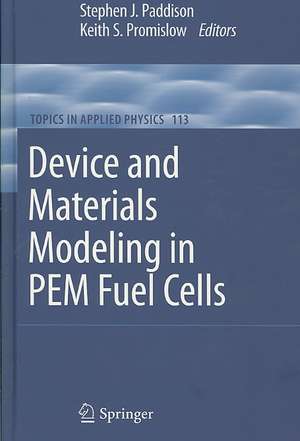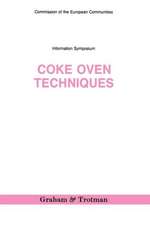Device and Materials Modeling in PEM Fuel Cells: Topics in Applied Physics, cartea 113
Editat de Stephen J. Paddison, Keith S. Promislowen Limba Engleză Hardback – 6 noi 2008
| Toate formatele și edițiile | Preț | Express |
|---|---|---|
| Paperback (1) | 1395.00 lei 43-57 zile | |
| Springer – 4 noi 2014 | 1395.00 lei 43-57 zile | |
| Hardback (1) | 1178.23 lei 38-44 zile | |
| Springer – 6 noi 2008 | 1178.23 lei 38-44 zile |
Din seria Topics in Applied Physics
-
 Preț: 426.94 lei
Preț: 426.94 lei - 18%
 Preț: 1400.06 lei
Preț: 1400.06 lei -
 Preț: 434.75 lei
Preț: 434.75 lei - 18%
 Preț: 1558.20 lei
Preț: 1558.20 lei - 18%
 Preț: 783.20 lei
Preț: 783.20 lei - 18%
 Preț: 730.65 lei
Preț: 730.65 lei -
 Preț: 386.00 lei
Preț: 386.00 lei -
 Preț: 387.96 lei
Preț: 387.96 lei - 18%
 Preț: 1233.06 lei
Preț: 1233.06 lei - 18%
 Preț: 1224.06 lei
Preț: 1224.06 lei - 18%
 Preț: 1386.30 lei
Preț: 1386.30 lei - 18%
 Preț: 2101.95 lei
Preț: 2101.95 lei - 18%
 Preț: 1221.38 lei
Preț: 1221.38 lei - 18%
 Preț: 2096.91 lei
Preț: 2096.91 lei - 18%
 Preț: 955.88 lei
Preț: 955.88 lei - 18%
 Preț: 1227.21 lei
Preț: 1227.21 lei - 18%
 Preț: 1230.03 lei
Preț: 1230.03 lei - 18%
 Preț: 1386.92 lei
Preț: 1386.92 lei -
 Preț: 392.60 lei
Preț: 392.60 lei - 18%
 Preț: 1830.65 lei
Preț: 1830.65 lei - 18%
 Preț: 1249.45 lei
Preț: 1249.45 lei - 18%
 Preț: 1836.63 lei
Preț: 1836.63 lei - 18%
 Preț: 964.71 lei
Preț: 964.71 lei - 18%
 Preț: 943.57 lei
Preț: 943.57 lei - 18%
 Preț: 949.10 lei
Preț: 949.10 lei - 18%
 Preț: 1217.58 lei
Preț: 1217.58 lei - 18%
 Preț: 959.19 lei
Preț: 959.19 lei - 18%
 Preț: 943.43 lei
Preț: 943.43 lei -
 Preț: 391.61 lei
Preț: 391.61 lei - 18%
 Preț: 1125.40 lei
Preț: 1125.40 lei
Preț: 1178.23 lei
Preț vechi: 1550.29 lei
-24% Nou
Puncte Express: 1767
Preț estimativ în valută:
225.45€ • 236.02$ • 186.55£
225.45€ • 236.02$ • 186.55£
Carte tipărită la comandă
Livrare economică 02-08 aprilie
Preluare comenzi: 021 569.72.76
Specificații
ISBN-13: 9780387786902
ISBN-10: 0387786902
Pagini: 588
Ilustrații: XX, 588 p.
Dimensiuni: 155 x 235 x 28 mm
Greutate: 1.11 kg
Ediția:2009
Editura: Springer
Colecția Springer
Seria Topics in Applied Physics
Locul publicării:New York, NY, United States
ISBN-10: 0387786902
Pagini: 588
Ilustrații: XX, 588 p.
Dimensiuni: 155 x 235 x 28 mm
Greutate: 1.11 kg
Ediția:2009
Editura: Springer
Colecția Springer
Seria Topics in Applied Physics
Locul publicării:New York, NY, United States
Public țintă
Professional/practitionerCuprins
Device Modeling.- Section Preface.- Modeling of PEMFC Catalyst Layer Performance and Degradation.- Catalyst Layer Operation in PEM Fuel Cells: From Structural Pictures to Tractable Models.- Reactor Dynamics of PEM Fuel Cells.- Coupled Proton and Water Transport in Polymer Electrolyte Membranes.- A Combination Model for Macroscopic Transport in Polymer-Electrolyte Membranes.- Analytical Models of a Polymer Electrolyte Fuel Cell.- Phase Change and Hysteresis in PEMFCs.- Modeling of Two-Phase Flow and Catalytic Reaction Kinetics for DMFCs.- Thermal and Electrical Coupling in Stacks.- Materials Modeling.- Section Preface.- Proton Transport in Polymer Electrolyte Membranes Using Theory and Classical Molecular Dynamics.- Modeling the State of the Water in Polymer Electrolyte Membranes.- Proton Conduction in PEMs: Complexity, Cooperativity and Connectivity.- Atomistic Structural Modelling of Ionomer Membrane Morphology.- Quantum Molecular Dynamic Simulation of Proton Conducting Materials.- Morphology of Nafion Membranes: Microscopic and Mesoscopic Modeling.- Molecular-Level Modeling of Anode and Cathode Electrocatalysis for PEM Fuel Cells.- Reactivity of Bimetallic Nanoclusters Toward the Oxygen Reduction in Acid Medium.- Multi-Scale Modeling of CO Oxidation on Pt-Based Electrocatalysts.- Modeling Electrocatalytic Reaction Systems from First Principles.
Notă biografică
Paddison is an associate professor of chemical engineering who works on computational studies of fuel cell materials. Promislow is a professor of applied mathematics working on device-level modeling of fuel cells and nonlinear optics.
Textul de pe ultima copertă
Device and Materials Modeling in PEM Fuel Cells is a specialized text that compiles the mathematical details and results of both device and materials modeling in a single volume. Proton exchange membrane (PEM) fuel cells will likely have an impact on our way of life similar to the integrated circuit. The potential applications range from the micron scale to large scale industrial production. Successful integration of PEM fuel cells into the mass market will require new materials and a deeper understanding of the balance required to maintain various operational states. This book contains articles from scientists who contribute to fuel cell models from both the materials and device perspectives. Topics such as catalyst layer performance and operation, reactor dynamics, macroscopic transport, and analytical models are covered under device modeling. Materials modeling include subjects relating to the membrane and the catalyst such as proton conduction, atomistic structural modeling, quantum molecular dynamics, and molecular-level modeling of the anode and cathode electrocatalysts.
Device and Materials Modeling in PEM Fuel Cells is ideal for professionals and researchers working with fuel cells, as well as electrical engineers and graduate students performing computational materials research, applied mathematics, and molecular physics.
Device and Materials Modeling in PEM Fuel Cells is ideal for professionals and researchers working with fuel cells, as well as electrical engineers and graduate students performing computational materials research, applied mathematics, and molecular physics.
Caracteristici
Utilizes multiscale approach to the chemical and physical phenomena of PEM fuel cells Contains both fundamental (i.e. materials) and applied research














